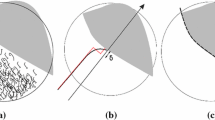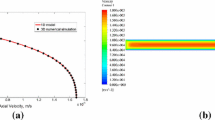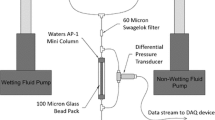Abstract
The polymer solution for polymer flooding is a viscoelastic fluid. There exist both shear flow and elongational flow when the polymer solution flows in a porous medium, where an additional dissipation is involved. The additional dissipation caused by elongational deformation is often ignored while studying the flow of the fluid in a porous medium. For a complex polymer solution, the generated elongational pressure drop cannot be ignored. In a capillary of fixed diameter, the polymer solution is only impacted by the shear force, and its rheological property is pseudoplastic. Therefore the variable diameter capillary and the converging-diverging flow model with different cross sections are required to describe the flow characteristics of the polymer solution in porous media more accurately. When the polymer solution flows through the port, we have the elongational flow and the polymer molecules undergo elongational deformation elastically. By using the mechanical energy balance principle and the minimum energy principle, a mathematical model of non-Newtonian fluid inlet flow was established by Binding. On the basis of the Binding theory, with the application of the theory of viscoelastic fluid flow in the circular capillary and the contraction - expansion tube, the relations between the viscoelastic fluid flow rate and the pressure drop are obtained.
Similar content being viewed by others
References
Petrie C. J. S. One hundred years of extensional flow [J]. Journal of Non-Newtonian Fluid Mechanics, 2006, 137(1–3): 1–14.
Petrie C. J. S. Extensional viscosity: A critical discussion [J]. Journal of Non-Newtonian Fluid Mechanics, 2006, 137(1–3): 15–23.
Liang J. Z. Quantitative description of entry converging flow of polymers [J]. Special Purpose Rubber Products, 2004, 25(3): 29–32(in Chinese).
Wever D. A. Z., Picchioni F., Broekhuis A. A. Polymers for enhanced oil recovery: A paradigm for structure-property relationship in aqueous solution [J]. Progress in Polymer Science, 2011, 36(11): 1558–1628.
Shen M. X. Synthesis and adhesion of polymeric hydrogels [D]. Doctoral Thesis, Shanghai, China: East China University of Science and Technology, 2014(in Chinese).
Dressler M. Shear flow properties of polymer blend models with and without droplet inertia [J]. Journal of non-Newtonian Fluid Mechanics, 2013, 200: 147–167.
Feng S. D. Study on controlling factors of viscosity of polymer solution in Daqing Oilfield [D]. Doctoral Thesis, Daqing, China: Northeastern Petroleum University, 2013(in Chinese).
Forest M. G., Heidenreich S., Hess S. et al. Dynamic texture scaling of sheared nematic polymers in the large Ericksen number limit [J]. Journal of Non-Newtonian Fluid Mechanics, 2010, 165(13): 687–697.
Sienz J., Bates S. J., Pittman J. F. T. Flow restrictor design for extrusion slit dies for a range of materials: Simulation and comparison of optimization techniques [J]. Finite Elements in Analysis and Design, 2006, 42(5): 430–453.
Liang F., Bao R. D., Jin Y. et al. Dynamic stability of a fluid-conveying carbon nanotube embedding in linear viscoelastic medium [J]. Journal of Vibration and Shock, 2015, 34(1): 140–144.
Habla F., Obermeier A., Hinrichsen O. Semiimplicit stress formulation for viscoelastic models: Application to three-dimensional contraction flows [J]. Journal of Non-Newtonian Fluid Mechanics, 2013, 199: 70–79.
Kozdon J. E., Mallison B., Gerritsen M. et al. Multidimen-sional upwinding for multiphase transport in porous media [J]. Society of Petroleum Engineers, 2011, 16(2): 263–272.
Tian Z. P., Zhang B., Cui H. Q. etal. Mathematical model and numerical calculation for viscoelastic fluid flow through fractal porous media [J]. Acta Petrolei Sinica, 2014, 35(1): 118–122(in Chinese).
Binding D. M., Phillips P. M., Phillips T. N. Contraction/expansion flows: The pressure drop and related issues [J]. Journal of Non-newtonian Fluid Mechanics, 2006, 137(1–3): 31–38.
Yang F. L. Mechanism of polymer flooding and a new enhanced oil recovery of high-concentration polymer flooding [D]. Doctoral Thesis, Daqing, China: Daqing Petroleum Institute, 2004(in Chinese).
Zhang H. F., Wang D. M., Wang L. J. Flow laws of po-lymer solution in porous media and their mechanism on enhancing displacement efficiency [J]. Petroleum Geology and Oilfield Development in Daqing, 2002, 21(4): 57–60(in Chinese).
Xia H. F., Wang D. M., Liu Z. C. Study on the mechanism of polymer solution with visco-elastic behavior increasing microscopic oil displacement efficiency [J]. Acta Petrolei Sinica, 2001, 22(4): 60–65(in Chinese).
Wang D. M., Chen J. C., Yang Q. Y. Viscous-elastic po-lymer can increase micro-scale displacement efficiency in cores [J]. Acta Petrolei Sinica, 2000, 21(5): 45–51(in Chinese).
Baag S., Acharya M. R., Dash G. C. et al. MHD Flow of a visco-elastic through a porous medium between infinite parallel plates with time dependent suction [J]. Journal of Hydrodynamics, 2015, 27(5): 738–747.
Hayat T., Awais M., Obaidat S. Similar solution for three-dimensional flow in an Oldroyd-B fluid over a stretching surface [J]. International Journal for Numerical Methods in Fluids, 2012, 70(7): 851–859.
Koshiba T., Hashimoto T., Mori N. et al. Pressure loss of viscoelastic surfactant solutions under the flow in a packed bed of particles [J]. Journal of the Society of Rheology, 2007, 35(1): 21–26.
Author information
Authors and Affiliations
Corresponding author
Additional information
Project supported by the National Natural Science Foundation of China (Grant No. 51574085), the Natural Science Founaation of Heilongjiang Province (Grant No. F2015020) and the Science and Technology Research Project of Department of Education of Heilongjiang Province (Grant No. 12521059).
Biography: Er-long Yang (1976-), Male, Ph. D., Professor
Rights and permissions
About this article
Cite this article
Yang, El., Gu, Tt., Wang, M. et al. Application of binding theory for seepage of viscoelastic fluid in a variable diameter capillary. J Hydrodyn 29, 621–631 (2017). https://doi.org/10.1016/S1001-6058(16)60775-8
Received:
Revised:
Published:
Issue Date:
DOI: https://doi.org/10.1016/S1001-6058(16)60775-8




